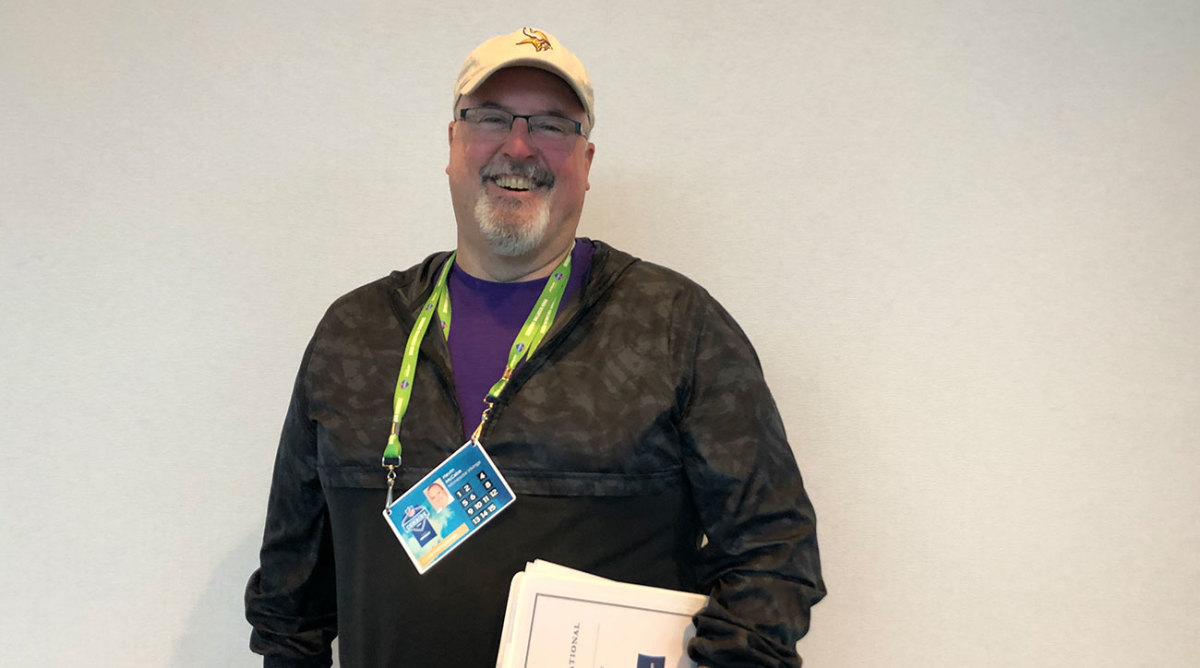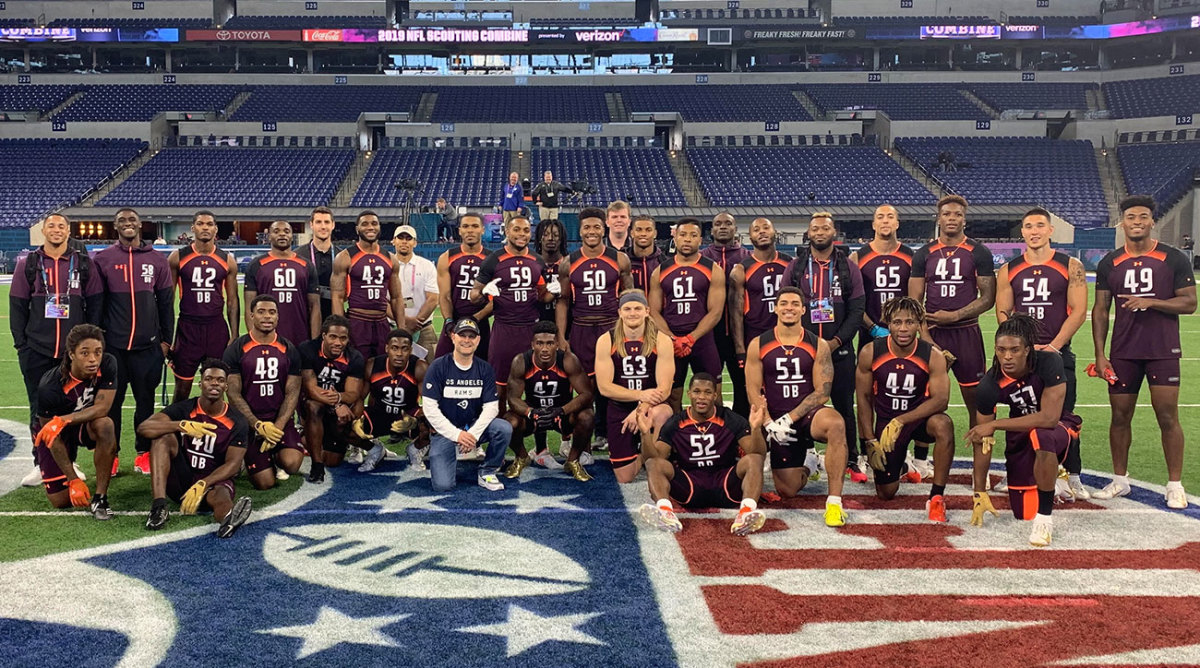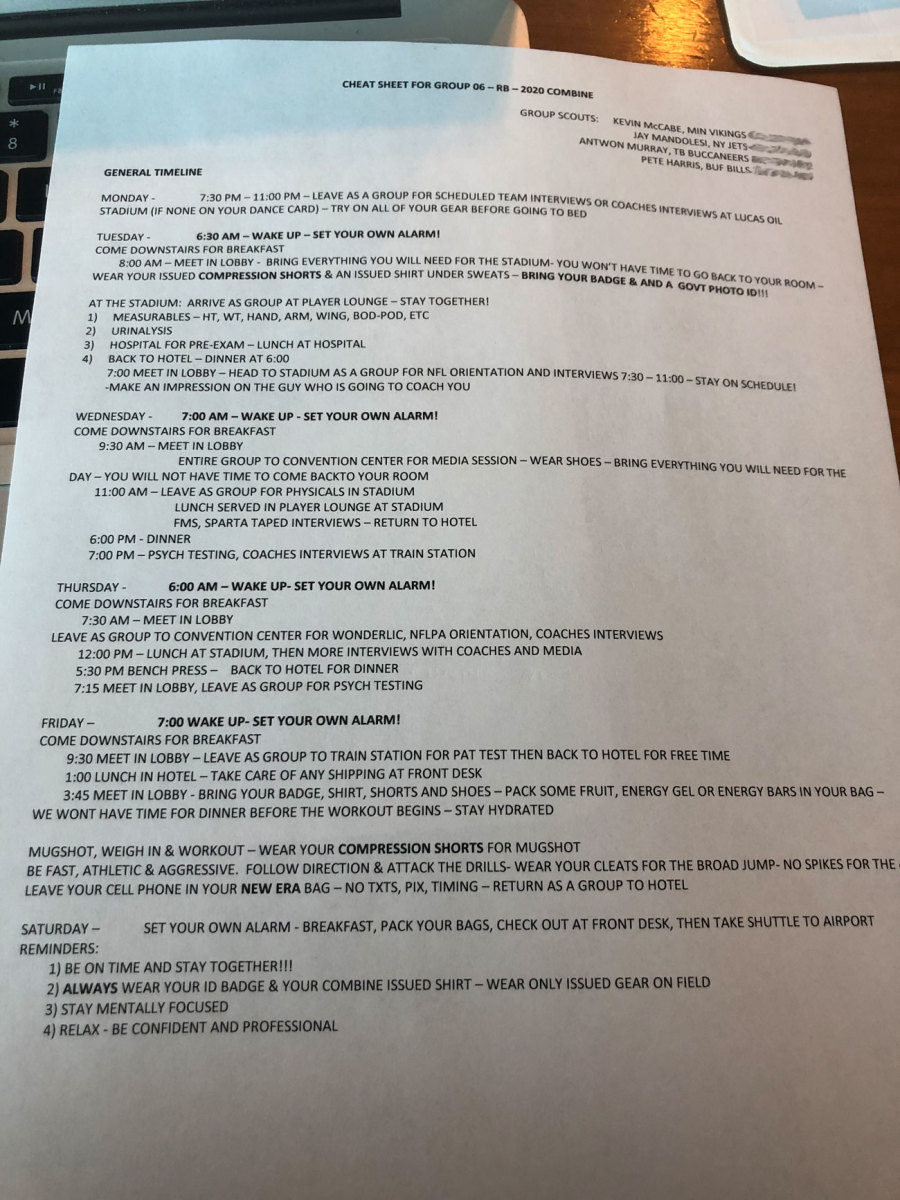Meet the Group Scouts—the Camp Counselors Who Run the NFL Combine

INDIANAPOLIS — Kevin McCabe opens a white three-ring binder and turns it to a list of 30 names.
“Hey fellas,” he tells the group of running backs assembled just in front of the elevators in the lobby of the Crowne Plaza. “Every single drill, every single situation we're in, we are going to get lined up alphabetically. So find out who is in front of you, who is behind you. If somebody is missing, let me know.”
Before prospects participate in any of the scheduled drills or workouts at the NFL Scouting Combine, they must first master one of the more difficult components. Roll call.
McCabe scratches his white goatee. “RBs, listen up. Salvon, Cam, Jet, LeVante …”
It’s early in the morning, and the players are dressed in their combine-issued black-and-white New Era sweatsuits. They hurry to organize themselves single-file according to McCabe’s list. Each player looks at the sleepy face in front and behind him, eagerly committing his place in the Group 6 line to memory. “I know it seems kind of like kindergarten, but it's not,” McCabe says. “There's a reason why we do it this way, so be patient.”

It takes a small army to put on the combine each year. National Football Scouting, the service that produces the combine, relies on about 200 volunteer workers from all 32 teams. Each team is required to offer up a certain number of employees to work in different roles. Scouts volunteer to run different stations like the 40 or the bench press, or conduct the taped interviews with each prospect that are sent out to every team. But the most important job are the group scouts like McCabe, who are tasked with getting each prospect everywhere they need to be in a timely fashion. For five days, the 47 group scouts lead their position group through medical testing, interviews, media, on-field workouts, weigh-ins and more.
They send repetitive group texts, juggle complicated schedules, fend off pesky agents pulling their players out of line, field completely unnecessary 3 a.m. phone calls, rescue hangry prospects with well-timed snacks, organize bathroom breaks, check uniforms and read off roll call about 97 times. It’s a 24/7 behind-the-scenes job with a description that reads like a babysitter or camp counselor.
McCabe nods his head and laughs at the fitting babysitter/camp counselor comparison, but he prefers the much smoother title “facilitator.”
The Vikings’ West Coast–area scout is the facilitator for the 30 running backs in Group 6. He has been doing this job for 24 years and realized this week just how long it’s been when he ran into Hines Ward at the players’ hotel in Indianapolis. Ward was one of McCabe’s prospects back in 1998, when McCabe was a young group scout for the receivers. “I said, ‘Dude I haven't seen you since you were here as a participant in my group!’ McCabe says. “He was like, ‘Yeah, man, that was 22 years ago!’”
There isn’t much turnover among the group scouts from year to year. The spots are valuable for evaluating prospects up close and personal, so teams try to hold on to them as long as possible.
Ted Monago has been the leader of Group 11 (defensive backs) for the last 17 years. Monago, a former walk-on cornerback at Arizona State and now the assistant director of college scouting for the Rams, is serious about his job as a combine guide. He gushes about his group with enthusiasm.
“I tell the guys that we do actually care,” Monago says. “You are the last group, but you are the group that we really want to be the best group. We tell them we want this to be a great experience for you. That is really important, that the players have a good experience. It is just like when you went to camp when you were a kid. O.K., how was your experience? Because they all are going to ask guys from the year before, hey, what was it like?”
Monago has saved every one of his group scout binders and keeps them stacked in order on a shelf in his home office. He takes a group photo every year on the field at Lucas Oil Stadium and texts it to each of his prospects, as a keepsake to remember the five days they spent together. He can quickly list a few of the defensive backs he’s worked with who have landed spots in his personal DB prospect Hall of Fame: Thomas Davis, Patrick Peterson and Carlos Rogers.

When McCabe and Monago first took on their group scout positions, early in their scouting careers, the job was typically considered a chore for newbies. “Since then it has evolved and become a pretty sought-out position,” McCabe said. “People have started viewing it differently. You realize it is not a punishment where you have to babysit these kids. You are actually trying to figure out, O.K., how do they respond to pressure? Are they self-motivated enough to show up on time?”
Most prospects are well-prepared by their agents and aware that their group scout is not an innocent observer. But Monago says he can sense the prospects let their guard down a bit after the first couple of days.
“We tell them when we first meet them, listen, you are being watched 24/7,” said one group scout. “But we don’t exactly tell them that yes, we're part of that, too.”
It’s not uncommon for a team to place their group scouts strategically. Clubs have to submit their volunteer worker requests online to National Football Scouting each year, and they can make a note to request a switch to a different position group. Jeff Foster, the president of National Football Scouting, will accommodate the request when he can. He doesn’t allow a team to have more than three group scouts. If he can’t make the change himself, the teams are free to trade among themselves.
This year, an NFC North team requested to switch one of their scouts into a defensive line group, because the team has a need at the position. Foster made the switch.
Several group scouts said that teams in the quarterback market would all naturally like to have a group scout be in position to get a little more insight into that group. One season not too long ago, a quarterback-needy team requested one of their scouts be assigned to one of the two quarterback/wide receiver groups, and that team drafted a QB in the top 10 in the year of the reassignment.
“It happens more than people think,” said one scout who has never been a group scout himself, but annually compares notes with group scout pals.
This year, the quarterback position group scouts saw one change, with the Miami Dolphins' inserting another scout into the position group. The QB group scouts are now Chargers, Titans, Dolphins, Saints, Jets, Bills, Dolphins and Seahawks.
The reason for the update might just be the new position groups' numbers this year. The quarterbacks are now the first group, when they were previously in the middle, after the offensive linemen. Some scouts preferred staying with the same group number rather than the same position. But it’s interesting to note that in a year that Miami will almost certainly draft a QB, the Dolphins have a group scout in each of the two QB position groups.
Six years ago, shortly after the combine, Foster says he got an interesting call from a general manager: “Hey, can you send me the list of all the group scouts and their phone numbers?”
Foster thought about it. The GM could probably find the information on his own, so he felt comfortable providing him the list. “Sure, but tell me why you want it,” Foster said. The GM said he wanted to ask group scouts about their experience at the combine with a handful of players he was interested in.
“I thought it was really interesting that a general manager might call a scout from another team and try to get information,” Foster said. “That shows you how valuable it is.”
Scouts are typically wary of sharing information with competitors, but in this case, the group scouts I spoke with were all open to sharing their opinions on prospects with friends on other teams. Each year, while he sits and waits for his group to go through medical testing, one assistant group scout said he will compare personality notes on the players with the group leader.
“I won’t hold back if asked,” said another scout.
“Word travels fast on who the good and bad guys were all week,” said one former group scout.
Because there is so little turnover, most scouts know exactly who to go to if they have a question about a certain prospect they are targeting.
“If you think about it, we have 17 QBs here, and at their school, those 17 QBs are the leaders of their team,” Foster said. “But when you put 17 leaders together, who becomes the leader of the leaders?”
Browns quarterback Baker Mayfield was that alpha when he participated in the combine in 2018. “He wanted to be the guy amongst his group,” said one person familiar with the quarterback group. “He looked at Josh Rosen and he realized, well, I have to trump you, and he did.”
Along with being the Vikings' West Coast scout, McCabe cross-checks running backs, which means he’s usually very familiar with the prospects in his group. He says his experience interacting with Vikings running backs Dalvin Cook (second round, 2017) and Alexander Mattison (third round, ‘19) at the combine were considered when Minnesota discussed those players in the lead-up to their respective drafts. “Alexander was very curious about the process, so you could tell he was a deep thinker,” McCabe said. “Dalvin came on a mission and he was laser focused.”
The combine takes place in a disorienting vortex of identical hotels, all connected via skywalks that funnel into the convention center, a sprawling expanse of outdated carpeting and hallways marked with confusing signage. Steep escalators lead only to more hallways with more of the same distracting carpet, and countless entrances and exits. Monago once lost a player when he wandered off into the wrong hotel. “He thought we were in the Westin and we were in the Crowne Plaza,” Monago said. “People get turned around here real easily.”
Group scouts constantly remind their prospects to check in with them before they go off to use the restroom. McCabe once lost a player during weigh-ins when he snuck off to the bathroom. “Part of it is, c'mon, fellas, hold it,” McCabe said, laughing. “We can hold it for 10 more minutes. We have to get through this one thing and then we've got time.”
Monago runs a tight ship with his defensive backs, a position group that has a reputation among group scouts for being one of the more difficult to manage because of the size of the group and some strong personalities. “I don't like to say I have rules,” Monago said. “But we have policies and standards.”
Like, put a shoe on top of the toilet the night before drug testing so you remember not to pee before your test. Do not lose your credential—a very common offense. Do not lose your phone. Do not be late. Do not stop to talk to anyone outside of your group on your way from Point A to Point B.
Texting has made the job of a group scout infinitely easier. McCabe adds each of his 30 running backs into his contacts, with the helpful identifier 2020 RB in the “company” section, and then puts them all into one giant group text. He isn’t tech savvy enough to know how to “name” the group text, but he has kids of his own, so he knows enough to throw a flex arm emoji into his Welcome to Indy group text.
Before the cellphone era, the job of a group scout was much more intense. “It was a lot of calling the room and pounding on the door,” McCabe said.
“It was like the Wild West then,” said one NFL evaluator who was a group scout during the pre-cellphone stone ages.
McCabe sleeps with his phone on loud so he can be available to his players any time. Once, a player woke him up at 1 a.m. wondering where he could get food at that hour. Another time, a prospect woke him up at 3 a.m. asking what time the wakeup call was the next day. McCabe sighed, knowing this information was readily available elsewhere, but he answered nicely.
What time do we have to get up tomorrow? is by far the most common question prospects pester group scouts with during the week. On the cheat sheet that McCabe passes out to each of the running backs in his group, he purposely puts the wakeup time in bold capital letters, and even adds a helpful reminder “7:00 AM - WAKE UP - SET YOUR OWN ALARM!”

“I would think in this environment you might want to read it twice,” said another group scout, who shares the same frustration.
Even though a lot of the work is exhausting, several group scouts mentioned they keep coming back to the job because it’s a hell of a lot more interesting than the alternative. “I like doing it because the combine is so monotonous,” one group scout said. “During the day I don’t have to sit there and time 40s and watch position group workouts.”
Each year, Foster leads an orientation for group scouts the day before the combine kicks off. This year’s meeting went three hours, twice as long as usual because of all the schedule changes this year.
With the prime-time workout schedule this year, quarterbacks, wide receivers and tight ends moved up to the first position group that kicks off the combine. Before this year, offensive linemen had always been the first group. As one of the more anonymous position groups, offensive linemen have a reputation of being low maintenance and easygoing, making them the perfect guinea pigs to start the week.
“They clear the way,” Foster said. “We only do this once a year, so for all the multitude of people and moving parts, it takes us one go-round to get our wheels greased again. The offensive linemen have always been great grease.”
Sometimes, a situation arises that calls on a group scout’s skills in conflict resolution. In 2009, Alabama tackle Andre Smith left the combine a day early without informing his group scout. In 2014, San Diego State running back Adam Muema would not leave his hotel room because he said God told him he did not need to work out. Muema was McCabe’s prospect, and his most challenging experience as a group scout. He declined to comment on the details of that situation.
Monago and McCabe both have backgrounds in coaching, and that interest in mentoring young players is what pulls them back to the group scout role year after year. And any young scouts eyeing these veterans’ spots should know these two aren’t going anywhere anytime soon.
Sprinkled among the directions on McCabe’s cheat sheet for Group 6 are a few clues that he’s coming at this with a coaching mind-set. Right next to where formal interviews are listed on the schedule, he’s typed, MAKE AN IMPRESSION ON THE GUY WHO IS GOING TO COACH YOU.
The last day of the combine always ends with Monago and Group 11’s on-field workouts. For many club personnel, the sound of Monago’s voice on the microphone signals the finish line of a very long week. “I’m the caboose, the closing act,” he said. “They see me at the mic and they’re happy.”
And after the last defensive back position drill is whistled complete, a weird disconnected feeling settles over him, almost like withdrawal. “I care,” he said. “I really care. I am 51 years old and still care about what these kids are doing.”
“Well, we aren’t curing cancer or negotiating world peace,” McCabe said. But for seven days every February in Indianapolis, these camp counselors are among the most important men in the NFL.
Question or comment? Email us at talkback@themmqb.com.
